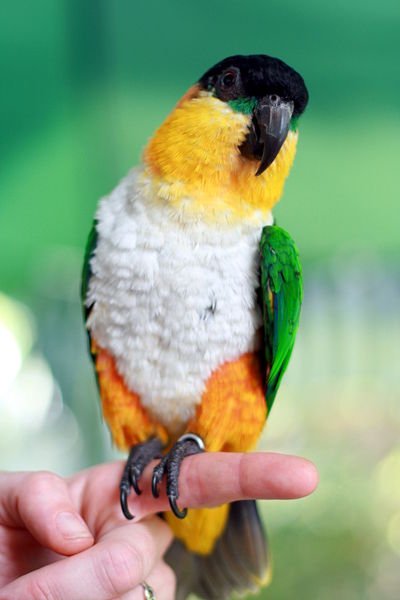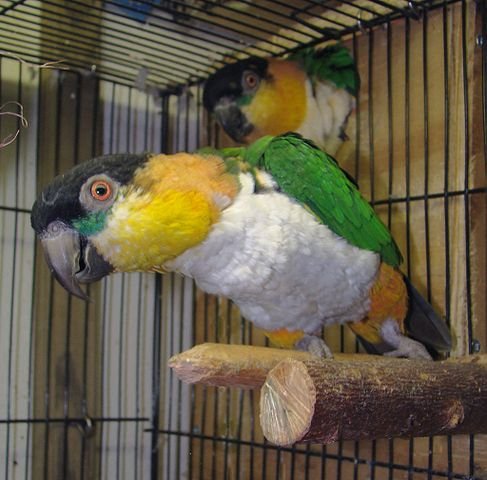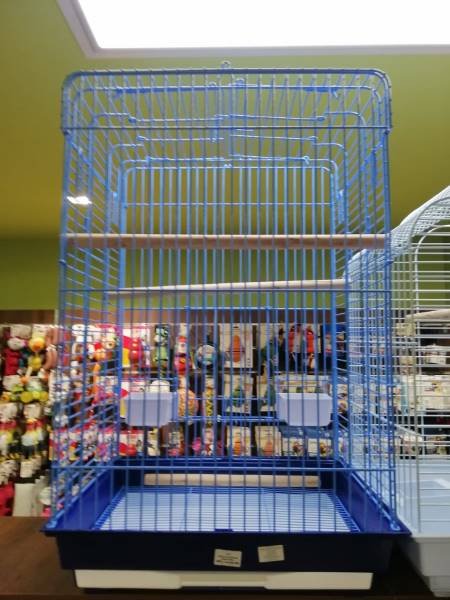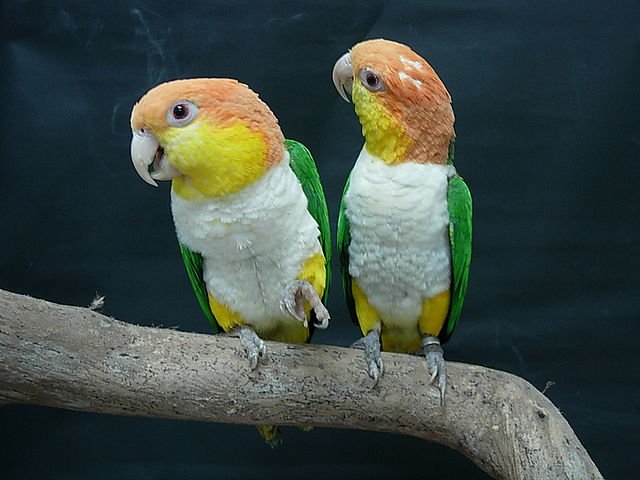Parrots have always been a great human companion and the more of them as pets the happier the human is. And why shouldn’t they be? They are such fun to be with. One such fun and quirky species that has been popular across the globe is a Black-headed Caique. Native to the South American’s Amazon region, specifically to Peru, Bolivia, Brazil, Venezuela, and Columbia, they reside in the swampy tropical or subtropical lowlands. Often found on the treetops, they can be spotted with their flock members, with 10 to 30 members staying together.
Black-Headed Caique Size
Around 10 inches from head to toe, these parrots have a black-colored forehead, head and nape, bright-green plumage, wings, and tail, yellow-colored neck and thighs, white bellies, grey beak, and black feet. A black-headed Caique baby has yellow bellies instead of white. They weigh around 130 to 170 grams.
One might find certain variations in the usual color taxonomy. The reason is their further classification into two subspecies.
Know Black-Headed Caique Names
Pionites Milanocephalus, as they are known scientifically, the Black-headed Caique, has many names to his credit. Apart from the most commonly used name, black-headed Caique, they are also widely known as the Pallid Partro or simply the Black-capped Parrot.
The black-headed Caique also has two subspecies that distinguish him from his cousin, the White-bellied Caique. These subspecies have the following characteristics:
Pionites Milanocephalus Milanocephalus
This subspecies is found in the eastern range of his habitat in South America’s Amazon. They have dark orange nape, orange thighs, and a white belly.
Pionites Milanocephalus Pallidus
This subspecies is found in the eastern range of his habitat in South America’s Amazon. They have light orange nape, yellow thighs, and a white belly tinged with a light yellow tone.
Increasing Black-Headed Caique Lifespan
Not much has been known about black-headed Caique life expectancy. But it has been reported that the average age of a Caique is around 30 years depending on his habitat.
Black-Headed Caique in the Wild
A black-headed Caique’s life in the wild has not many records so far. But as inferred from the reports, he lives for an average of 27 to 30 years when in the wild. This age is quite lower than otherwise. And the reason could be exposure to lack of care, or dangers in the wild.
Black-Headed Caique in Captivity
A black-headed Caique’s lives much longer than his counterparts in the wild. The reason being, he has a much better quality of life while in captivity. They live for a minimum of 30 years in captivity with average care but if cared properly by a hands-on owner, they can prove to be a long-term companion, being around for roughly 40 years. But to make this happen, Caiques would need a caring and loving owner.
Know Black-Headed Caique Personality
A black-headed Caique has as colorful a personality as his appearance. There are many facets to this mid-sized parrot that can help one care for the bird more efficiently.
Energetic
One can find his Quaker or Conure energetic until he sees a Caique in his full form. He is always on a new high to perform a new trick or pull a prank, even before the last one is practically over. Owners generally find their Caiques on the cage’s floor, on their backs and performing tricks back to back. The word ‘energetic’ doesn’t do justice to their real energy levels. They get huffed and puffed and start again, without any break, thereby always keeping the owner on his feet.
Playful
A black-headed Caique has an extremely playful and fun-loving persona. He is known to be a social pet parrot that loves entertaining everyone around him with his comical tricks. He is never out of ideas to keep himself engaged and others happy. He is constantly on the go, to find his next best game that can keep him and his flock members entertained better than the previous.
Cuddly
There has been a misconception about Caiques that they aren’t cuddly at all. Caiques are known to be cuddly enough to be termed as a personality trait. Though they aren’t as cuddly as a Cockatoo. Caiques are famous for being companion birds because they can form a very close and strong bond with their human companion owing to their flock-nature. Simply a dedicated effort on the owner’s part to devote time to his bird and he will soon find this little bird on his lap, lying on his back, and having a great time with his favorite human.
Moody
One moment a Caique will be the owner’s best friend, refusing to live without him for a moment, and the next moment, he can nip his favorite human hard enough to make him bleed. Courtesy, his mood swings. And owing to his moody personality, he is hardly cohabitated with any other pet bird. The reason being, more often than not, he ends up attacking his cagemate after his sudden mood swing.
Black-Headed Caique Talking Prowess
Talking ability isn’t the quality a black-headed caique is known for. Though they can be trained to speak a word or a few, they cannot compete with an African Grey or a Quaker in terms of learning vocabulary and phrases. They are known to learn their name or, their owner’s name, or a few such words and that’s too, in a very unclear manner. Most of the time, they prefer to use their ‘bird language’ only.
However, this does not mean that they have no speech-related talent. They are very good at mimicking certain sounds they happen to hear from their surroundings like that of a ringing bell, creaking of a door, etc. They also become quickly adept at whistling the tunes of the songs they hear most often.
Understanding Black-Headed Caique Behaviour
A black-headed Caique behavioral traits resemble more with a strong-headed parrot species like Quaker. They have a temperament that would need the owner to take some time and understanding to get adjusted to.
Territorial
Caiques are infamous for not getting along well with their cage mates. Therefore, they are mostly kept alone in their separate cage. This can be blamed on their territorial behavior. These little birds don’t like sharing their space with anyone else. And if they happen to do so, they ignore the other bird and make sure that they reside in a small corner of the cage, almost always. And this becomes more evident between a breeding pair, as being territorial is also a highlighting trait of a black-headed Caique’s mating behavior.
Aggressive
Being overly energetic, at times, makes a black-headed Caique release his extra built-up energy in the form of aggression. Thus, he ends up fighting with his cage mates, mating partner, or human companion. The instances of a black-headed Caique biting his human is justified by this trait. His bite can be so hard that one can bleed immediately. Hence, there is a need to control his biting behavior at a young age.
Black-Headed Caique Diet Care
A black-headed Caique can live up to 40 years in captivity. Ut this mean feat can be achieved only if he is fed the perfect and balanced diet. A balanced diet is the one that has all the minerals, nutrients, and vitamins in a perfect proportion.
Fresh Fruits and Vegetables
Fruits and vegetables are a vital component of a black-headed Caique’s daily diet. And they are best served fresh. Dried fruits can be unhealthy for him as they contain sulfur. Out of fruits, Caiques love apples, bananas, pineapples, apricots, plums, peaches, tomatoes, berries, cherries, and passionfruit. Fruits like grapes might also be served, but in small quantities, as they have high sugar content.
When it comes to vegetables, Caiques love carrots, broccoli, corn, sweet potatoes, pumpkins, and winter squash. For their share of greens, serve them collard greens, spinach, watercress, or kale, and they will be more than happy.
But before serving them his favorite fresh feed, do not forget to remove the seeds as they can be fatal for the bird. Also, do not serve these as wholes, cut them in small pieces, or puree them before serving. Caique’s size preference must be kept in mind while chopping them but it should be biteable.
Seeds
All pet birds know that seeds are an important part of a bird’s diet. But they must be served in small quantities only. Seeds contain a good amount of fats and proteins. An overdose of these can disturb the optimum nutrient profile in the bird’s body. Caiques love seeds like amaranth, buckwheat, quinoa, chia, pumpkin, or barley. One can either serve them one by one by rotation on different days or feed them in the form of a mix of a few. This way, the bird wouldn’t feel bored of eating the same mix daily.
Before serving the seed mix, make sure to cook, soak, or sprout them to make it chewable for the Caique. Also, one can find numerous seed-mixes on sale these days. They contain a lot of preservatives and added fat. Make sure to make a fresh and organic mix at home for the bird’s good health.
Pellets
Every pet parrot is served pellets as they have all the nutrients that a bird needs to maintain an optimum nutrient profile. Pellets have all the necessary nutrients, minerals, and vitamins that a bird might be lacking in his diet. The Caique must be served only a high-quality pellet mix from a reputed brand. One can find them at pet stores or online. And lastly, pellets should be at least 50 percent of a Caique’s diet but, in no case, they must form more than 70 percent of his total dietary needs.
Fresh Water
To perform all his bodily functions, maintain optimum body temperature, and stay hydrated, a black-headed Caique needs an unrestricted supply of freshwater. It is imperative that this water is of drinkable quality, i.e., it must be free from all the chemicals and trace elements like lead. Hence, the owner must ensure that his bird has access to the freshwater all the time. One must keep a water dish in his cage to ensure this. Also, in summers, it is advisable to keep an extra water dish as the bird might feel thirst quite often due to high temperatures.
Black-Headed Caique Breeding Care
A black-headed Caique generally becomes sexually mature at the age of 2 years. But they hardly mate before 3 years. For breeding purposes, the owner must add a nest box either inside or outside the cage. The black-headed Caique nest box must be made of non-toxic wood with a minimum size of 8 inches length, breadth, and height, it can be bigger though. Line the floor of the nest box with natural organic wood shavings to keep it insulated. Also, place the nest box at a darker corner of the main cage. But do not forget to clean it regularly.
The black-headed Caique breeding season is late spring. The female lays around 3 to 4 eggs in a clutch. The eggs are incubated by the female for around 24-27 days. Meanwhile, the male Caique contributes by feeding the female and taking care of all other nest activities. Caiques are infamous for not being able to raise more than two chicks at a time that results in the death of the others. Therefore, the third and fourth laid eggs are generally removed from the nest box for hand-rearing. The parent-reared chicks leave the nest after about 14 weeks.
Read More about Caique Gender difference
https://parrotquaker.com/caique-parrot-gender-difference/
Fulfilling Black-Headed Caique Cage Needs
A cage is to a Caique, what a home is to a human. Therefore, it has to be self-sufficient to make his life comfortable. After all, he will be spending all his life there and living 30-40 years in a small and boring cage is impossible. The bird could succumb to boredom and then depression anytime. Therefore, his cage setup must be done very carefully:
Cage Size
A black-headed Caique cage size needs a little deliberation, given his super-fun and playful nature. It would be perfect if he can have a place where he can play, jump, and hop, without feeling restricted. Therefore, a cage size of 24 inches in length, breadth, and height. If possible, a height of 36 inches would also be great.
Another thing is the bars of the cage. It must have both the horizontal and the vertical ones to make it easy for the bird to sit and hop around. Keep the spacing between the vertical bars of not more than half an inch for the safety of the bird.
Cage necessities
To live in a cage that lacks the items of daily use is like living in an empty home. Hence, the Caique’s cage must have all the daily necessities in his cage. And feeders are at the top of that pyramid. On average, a minimum of three feeders is necessary to add to the cage’s utility. One for serving him freshwater, another to keep the seed mix, and the last one to serve him the pellet mix. They can either be kept at the cage’s floor or hanged at appropriate heights with the help of the clippers. Do not forget to add a few perches of varied sizes.
Toys
Toys are an important part of a parrot’s life, especially of the one that is as playful and fun-loving as a black-headed Caique. Apart from being a source of entertainment for the bird, toys also serve as a channel to release the high-energy that a Caique contains. And given the extent of that energy, there need to be numerous toys in the cage to keep this bird engaged.
There are many toys that might interest this inquisitive and playful bird. Shiny and textured balls, foraging toys with hidden treats inside, spiral ladders, puzzle toys, etc. are the toys that will feed a Caique’s stimulated mind well. Rotate the toys to keep it unpredictable.
Black-Headed Caique Price
When it comes to adopting a Caique, one has to make a choice between Black-headed Caique vs White-Bellied Caique. Whereas the White-Bellied Caique is uncommon and hence costs almost double the price of a black-Headed Caique, the black-headed Caique is easily available. The black-headed Caique price starts from $800 and can go up to $1000 depending on the location and the breeder.
Summing Up
A black-headed Caique is a common pet bird, though not as common as budgies or conures. Reason being that not many people know about their upkeep. But it is not tough to make a black-headed Caique care sheet and stick to it. This includes the general care of maintaining a hygienic and comfortable living environment for the bird, feeding him a balanced diet, taking care of his cage needs, providing him enough sources of entertainment, etc.
Additionally, for an active and social bird like a Caique, care must be taken by the owner to devote sufficient time and attention to the bird not only to form a healthy bond but also not to let the bird feel lonely. Also, one must never forget that Caique is the bird that needs no other bird or cage mate but his favorite human to feel loved.





